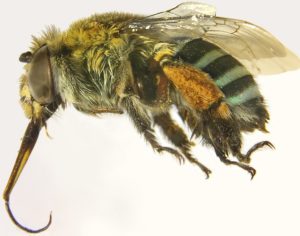Mapping pollinator networks
This project is now complete, and you can read the abstract of the final report here.
We are researching pollinator networks in Australia to improve our knowledge of Australian biodiversity. We are building networks of interactions between plants and their pollinators using new DNA technologies, including pollen DNA metabarcoding.

A blue-banded bee, Amegilla (Zonamegilla) asserta, from the Australian National Insect Collection. This specimen was collected in 1971 and still has pollen stuck to its legs. Photo by Juanita Rodriguez Arrieta.
A blue-banded bee, Amegilla (Zonamegilla) asserta, from the Australian National Insect Collection. This specimen was collected in 1971 and still has pollen stuck to its legs. Photo by Juanita Rodriguez Arrieta.
Along with fresh specimens, we’re using native bees, wasps and flies in the Australian National Insect Collection that were collected as long as 50 years ago and have pollen still stuck to them. From the pollen DNA we’re identifying the plant species these insects visited and matching this with field data and plant specimens in the Australian National Herbarium.
Our work will reveal how plant-pollinator communities have changed in the last decades and identify keystone species for ecosystem functioning and crop pollination in different areas of Australia.
Project Lead: Dr Francisco Encinas-Viso
